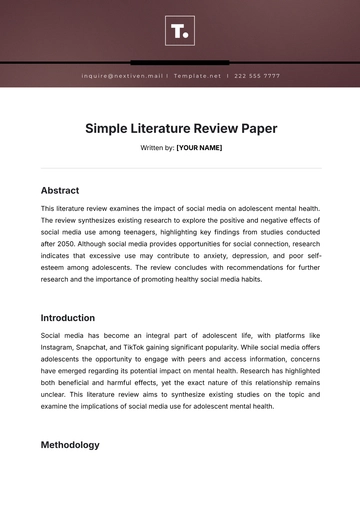Free Clinical Trial Research Paper

Prepared By: [Your Name]
I. Abstract
This paper explores the essential role of clinical trials in medical research by detailing their design, implementation, and analysis. It emphasizes ethical and regulatory considerations, outlines trial types and phases, reviews statistical methods, and presents case studies to illustrate their impact on advancing medical science and patient care.
II. Introduction
Clinical trials are crucial for advancing medical knowledge, determining the safety and efficacy of new treatments, and improving patient outcomes. This paper examines their design, execution, and regulatory and ethical guidelines.
III. Types of Clinical Trials
Clinical trials are classified based on their design and objectives. Understanding these types helps in comprehending their purpose and methodology.
A. Interventional Trials
Interventional trials, also known as experimental trials, test new drugs, devices, or procedures by comparing them against existing treatments or placebos. They are designed to determine the effects of the intervention on specific health outcomes. These trials often involve random assignment to different treatment groups to evaluate the intervention’s effectiveness and safety.
B. Observational Trials
Observational trials collect data on participants without introducing any intervention. Researchers observe and analyze outcomes based on natural variations in exposures or treatments. These trials can be cohort studies, case-control studies, or cross-sectional studies, and they help identify correlations and potential risk factors for diseases.
C. Prevention Trials
Prevention trials aim to determine the effectiveness of interventions designed to prevent diseases or conditions before they occur. These can include trials evaluating vaccines, lifestyle changes, or other preventive measures. They are crucial for identifying strategies that can reduce the incidence of diseases within populations.
D. Diagnostic Trials
Diagnostic trials focus on assessing the accuracy and effectiveness of new diagnostic tests or procedures. They are essential for improving early detection and diagnosis of diseases, which can lead to better management and outcomes. These trials often compare the new diagnostic method to standard or existing tests.
E. Screening Trials
Screening trials evaluate the effectiveness of screening tests in detecting diseases in asymptomatic individuals. The goal is to identify diseases at an early stage when they are more treatable. These trials are vital for developing effective screening programs that can lead to early intervention and improved prognosis.
F. Quality of Life Trials
Quality-of-life trials assess the impact of various treatments or interventions on patients’ overall well-being. These trials measure physical, emotional, and social aspects of patients' lives to determine how treatments affect their quality of life. This type of trial is essential for understanding the broader implications of medical interventions beyond just clinical outcomes.
IV. Phases of Clinical Trials
The development of a new intervention typically involves several phases of clinical trials, each with specific objectives and methodologies.
Phase I
Phase I trials are the first stage of testing a new intervention in humans. They typically involve a small number of participants (20-100) and focus on evaluating the safety, tolerability, and dosage of the intervention. Participants are usually healthy volunteers or individuals with the condition being studied. This phase aims to identify any adverse effects and determine the appropriate dosage for further testing.
Phase II
Phase II trials involve a larger group of participants (100-300) and focus on assessing the efficacy and safety of the intervention. This phase aims to determine whether the intervention has the desired effect on the condition being treated and to identify any common side effects. Phase II trials often involve participants with the condition the intervention is intended to treat.
Phase III
Phase III trials are conducted on a larger scale (300-3,000 participants) and aim to confirm the intervention's effectiveness, monitor side effects, and compare it to existing treatments or placebos. This phase provides a comprehensive evaluation of the intervention’s benefits and risks in a broader population. Successful Phase III trials are often required for regulatory approval.
Phase IV
Phase IV trials occur after the intervention has been approved for public use and marketed. These trials gather additional information on the intervention’s long-term effects, rare side effects, and effectiveness in diverse populations. They provide valuable data on the intervention’s performance in real-world settings and can lead to further refinements or additional indications.
V. Design and Implementation
The design and implementation of a clinical trial are crucial for obtaining reliable and valid results. Key elements include:
A. Randomization
Randomization involves assigning participants to different groups (e.g., treatment vs. placebo) by chance, which helps reduce selection bias and ensures that the groups are comparable. Randomization improves the validity of the study by minimizing the influence of confounding variables.
B. Blinding
Blinding, or masking, prevents participants and/or researchers from knowing which intervention the participant is receiving. This reduces bias in treatment administration, participant reporting, and outcome assessment. Single blinding means only participants are unaware, while double blinding means both participants and researchers are unaware.
C. Control Groups
Control groups receive a placebo or standard treatment, providing a benchmark against which the experimental intervention can be compared. This helps determine the true effect of the intervention by accounting for placebo effects and natural disease progression.
D. Sample Size
Determining the appropriate sample size is essential for ensuring that the study has enough power to detect a meaningful effect. Sample size calculations consider factors such as the expected effect size, variability in the data, and the desired level of statistical significance.
VI. Statistical Analysis
Statistical analysis is vital for interpreting clinical trial data and drawing valid conclusions. Common methods include:
A. Descriptive Statistics
Descriptive statistics summarize the main features of the data, such as central tendency (mean, median) and variability (standard deviation). These statistics provide a clear overview of the data distribution and help in understanding the basic patterns.
B. Inferential Statistics
Inferential statistics are used to make generalizations about the population based on sample data. Techniques such as regression analysis, t-tests, and ANOVA help determine if observed differences are statistically significant and not due to random chance.
C. Kaplan-Meier Estimator
The Kaplan-Meier estimator calculates survival probabilities over time and generates survival curves. It is commonly used in studies involving time-to-event data, such as patient survival in oncology trials.
D. Cox Proportional-Hazards Model
The Cox proportional-hazards model assesses the effect of various factors on the time of an event, such as disease progression or death. It allows for the adjustment of multiple variables and helps identify factors that significantly impact outcomes.
VII. Ethical Considerations
Ethical considerations are critical in clinical trials to protect participants and ensure the research is conducted responsibly. Core ethical principles include:
A. Informed Consent
Informed consent involves providing participants with comprehensive information about the trial, including its purpose, procedures, risks, and benefits. Participants must voluntarily agree to participate without coercion and have the right to withdraw at any time.
B. Beneficence
Beneficence requires that the potential benefits of the trial outweigh the risks to participants. Researchers must ensure that the trial is designed to maximize potential benefits while minimizing harm.
C. Justice
Justice ensures that the risks and benefits of the trial are distributed fairly among all participant groups. This principle addresses issues of equity and prevents the exploitation of vulnerable populations.
D. Respect for Persons
Respect for persons involves recognizing and honoring participants' autonomy, dignity, and rights. It includes respecting their decisions and privacy throughout the trial process.
VIII. Regulatory Framework
Regulatory frameworks are essential for ensuring the safety and scientific validity of clinical trials. Key bodies and guidelines include:
A. FDA (Food and Drug Administration)
The FDA regulates clinical trials in the United States, overseeing the approval process for new drugs and treatments. It ensures that trials meet safety and efficacy standards and that data is reported accurately.
B. EMA (European Medicines Agency)
The EMA regulates clinical trials within the European Union, providing guidelines and harmonizing standards across member states. It plays a crucial role in the approval and monitoring of new therapies in Europe.
C. ICH (International Council for Harmonisation)
The ICH provides global guidelines for clinical trial practices, aiming to standardize procedures and ensure consistency across different regions. Its guidelines promote the integration of international standards and best practices.
D. GCP (Good Clinical Practice)
GCP is an international ethical and scientific quality standard for designing, conducting, and reporting clinical trials. It ensures that trials are conducted with integrity and that participant rights are protected.
IX. Case Studies
Landmark case studies highlight the impact of clinical trials on medical advancements and public health.
A. Polio Vaccine
The 1954 clinical trial led by Jonas Salk was a groundbreaking study that tested the efficacy of the polio vaccine. It involved over 1.8 million children and demonstrated the vaccine’s effectiveness in preventing polio, leading to widespread vaccination and near-eradication of the disease.
B. AZT for HIV/AIDS
Early clinical trials in the 1980s established AZT (zidovudine) as the first effective treatment for HIV/AIDS. These trials marked a significant milestone in the fight against the HIV/AIDS epidemic, leading to improved patient outcomes and paving the way for further antiretroviral therapies.
C. Cancer Immunotherapy
Recent trials of cancer immunotherapies, such as checkpoint inhibitors and CAR-T cell therapy, have revolutionized cancer treatment. These therapies harness the body’s immune system to target and destroy cancer cells, offering new hope for patients with previously untreatable cancers.
X. Conclusion
Clinical trials are integral to the progress of medical science and the enhancement of patient care. They provide critical data that drive the development of new treatments and interventions, despite the complexities and ethical considerations involved. A thorough understanding of clinical trial design, implementation, and regulatory oversight is essential for researchers and healthcare professionals dedicated to advancing medical practice and improving patient outcomes.
- 100% Customizable, free editor
- Access 1 Million+ Templates, photo’s & graphics
- Download or share as a template
- Click and replace photos, graphics, text, backgrounds
- Resize, crop, AI write & more
- Access advanced editor
Document your clinical trials precisely using Template.net's Clinical Trial Research Paper Template. This editable and customizable template includes sections for study design, participant demographics, intervention details, and outcome measures. Editable in our AI Editor Tool, it provides a clear structure for presenting clinical trial data, ensuring your research is organized, comprehensive, and adheres to rigorous scientific standards.





























